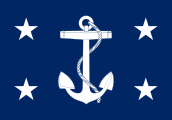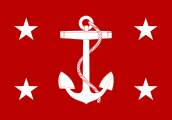Garrison Norton
Garrison Norton (October 9, 1900 – September 9, 1995) was Assistant Secretary of the Navy (AIR) from 1956 to 1959.
Biography
Garrison Norton was born in Chicago, the son of Charles Dyer Norton and the former Katherine McKim Garrison. He was raised in Washington, D. C. and Manhattan and attended the Groton School. He was educated at Harvard College, receiving a bachelor's degree cum laude in 1923.
After college, Norton joined the accounting firm of Arthur Young & Company. During this period, Norton became interested in aviation and received his Private Pilot License. This brought him in contact with several figures in the aviation industry, some of whom became his clients. He was made a partner of Arthur Young & Company in 1932.
Norton first joined the government in 1934, when he became deputy general manager of the Home Owners' Loan Corporation. He later went on to serve as assistant to the chairman of the Civil Aeronautics Authority and director of the Office of Transport and Communications in the State Department.
With the outbreak of World War II, Norton enlisted in the United States Navy, ultimately attaining the rank of captain by the war's end in 1945.
In 1947, President of the United States Harry S. Truman nominated Norton as an Assistant Secretary of State with responsibility for international transportation and communications. He held this office until 1949.
In the early 1950s, he worked for the United States Secretary of the Air Force in research and development.
In 1956, President Dwight D. Eisenhower nominated Norton as Assistant Secretary of the Navy (AIR) and he would serve in this office from July 7, 1956 until February 5, 1959. His primary goal as Assistant Secretary of the Navy (AIR) was with expanding the Navy's research and development capabilities. He was the last Assistant Secretary of the Navy (AIR), as the post was redesignated Assistant Secretary of the Navy (Research and Development) in 1959.
Norton left government in 1959, becoming president of the Institute for Defense Analyses until his retirement in the 1960s. He also went on to serve as chairman of the Carnegie Institution for Science.
He died on September 9, 1995 at the age of 94 in his home in Washington, D. C.
References
| Government offices | ||
|---|---|---|
| Preceded by James H. Smith, Jr. |
Assistant Secretary of the Navy (AIR) July 7, 1956 – February 5, 1959 |
Succeeded by James H. Wakelin, Jr. (as Assistant Secretary of the Navy (Research and Development)) |


